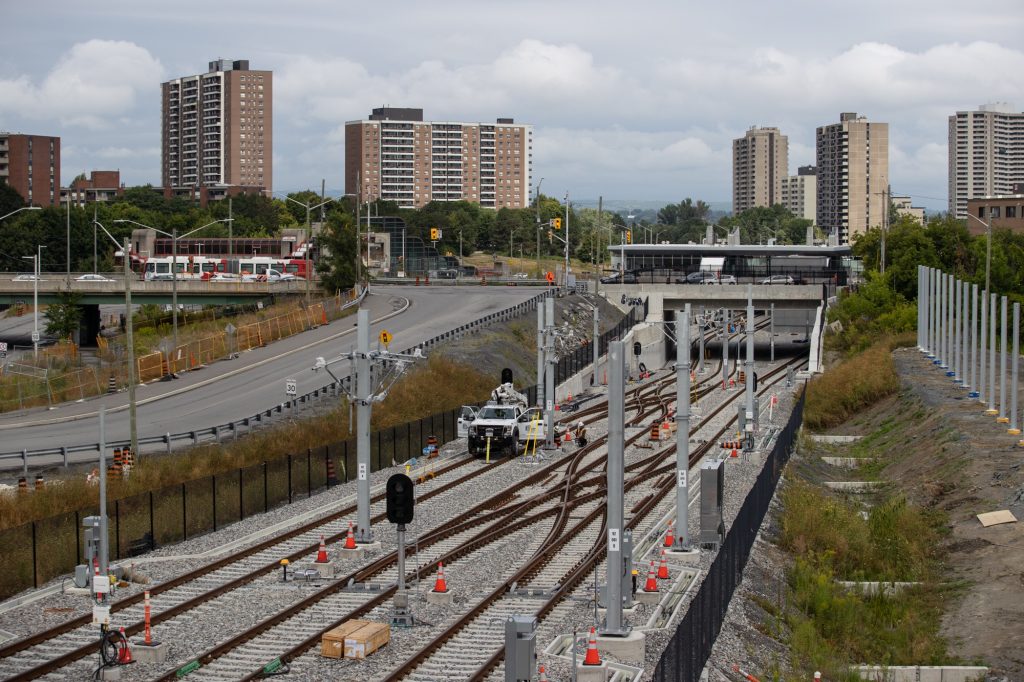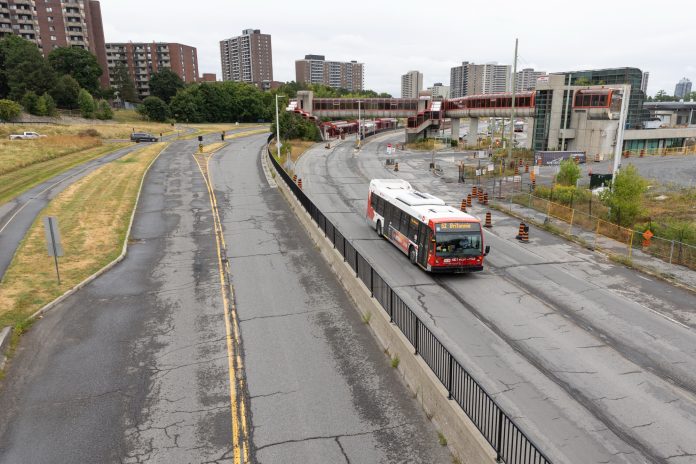For years, Woodpark residents have lived with the dust, detours and noise of light rail construction happening in their backyard. But once the trains start travelling from Tunney’s Pasture to Baseline Station in 2027, the concrete transitway that cuts through their neighbourhood will be decommissioned and replaced by new stretches of greenspace.
That is welcome news to Sue Milburn, president of the Woodpark Community Association. But she hopes the space will be used wisely – especially after parkland was temporarily removed during light rail construction.
“We did have access to NCC green space between the transitway and our neighbourhood. There was also a small city parkette at the end of Lawn Avenue on the entrance to the transitway but that has all been disturbed because of light rail,” said Milburn.
The area currently hosts a community garden and a multi-use path which connects Lawn Avenue to Carling. But it is overgrown with many invasive species, says Milburn. She would like to see it cleaned up and have playground equipment on the south side.
“It will be recreated, but that’s an area to walk through. Maybe there will be a park bench. You couldn’t put a place structure or anything like that and we already have a significant deficit with respect to community facilities and places for kids to play,” she added.
Long before it was the residential neighbourhood we know today, the Woodpark community was cottage country. The area was unplanned which, as a result, has led to narrow streets, ditches, odd-sized lots, and a lack of parkland, said Milburn.
New Orchard Park is the only small patch of community outdoor land available. It has a children’s play structure, but is too small for an outdoor skating rink in the winter or even a splash pad for summer. The community association needs to hold its meetings in the library because it has no access to a community building.
With the opportunity to now utilize the transitway land, city documents provide little information as to how it will be used for outdoor community space. Landscaping will begin in phases after the decommissioning of the transitway, with topsoil and sod being put down.

Bay Ward Coun. Theresa Kavanagh said the land is owned by the National Capital Commission. She has spoken with the organization recently and hopes it can be utilized for something innovative.
“Are we going to make it a great big skateboard park? It is going to be empty and goes all the way up to Iris. There are no plans at this time but it’s coming soon. We are only a few years away now,” she said.
Kavanagh would also like to explore what to do with the Pinecrest Creek which runs linear to the transitway.
Hundreds of years ago, the subwatershed ran through a deciduous forest. In the 1800s, that land was then converted into farm use. As neighbourhoods were built, smaller streams that flowed into the Pinecrest Creek were filled in, buried or moved. The lower 1.5km of the creek now flows through a large underground pipe.
“I would like for the NCC to daylight the creek, which they have not agreed to,” said Kavanagh. “This is the perfect opportunity to expand some trail networks or put in some interesting, funky features. But things seem to take a long time to do anything in Ottawa. When there’s no plan, it feels like this is a way distant opportunity when it maybe doesn’t need to be.”
There is also the possibility of some affordable housing being built on some land parcels in the area. That includes at the intersection where a large ramp takes vehicles from Carling Avenue to the Kichi Zibi Mikan Parkway. Plans include the possibility of making that a ‘T intersection’ instead, which would take up less space than the current configuration.
Keeping up with intensification
The communities around Woodpark are set to see massive development over the coming decades as the city pushes to build upward in areas around transit hubs. Both the Lincoln Fields and New Orchard light rail stations are situated in the community.
Most in the neighbourhood are excited to see the arrival of light rail, Lemay says, but worries about how the community’s infrastructure can keep up with population growth. The biggest changes will be seen in areas off the busy roads where three-storey homes with upwards of six units can now be built on single lots.
Milburn, who is from Toronto, questions where all those additional cars are going to be parked and said it’s unrealistic to think everyone won’t drive and just take public transit.
“Many people have jobs that aren’t easily accessible by transit. Those cars are going to go somewhere. We’d really like some help from the city to design the appropriate parking restrictions. Right now, we have a complete dog’s breakfast of parking restrictions,” she said.
“For example the street next to mine changed their rules to have no parking so that a garbage truck could get into a condo development to get the garbage out. Then all of a sudden, those cars now are parking on our street,” Milburn added. “If we have no parking or restrictions, those cars will just move to another street and create problems there instead. We need a holistic approach.”
There is also the concern over greenspace. More residents should mean more space for outdoor activity, she says.
The Current Lincoln Fields Secondary Plan – which the Woodpark Community largely opposes – will shape development at the former shopping mall plaza next door. Highrises, a new main street, and parkland are all part of the plan.
But Milburn feels it is not enough to help residents on her side of the transitway. She said that since the Woodpark area has had to suffer more than other parts of the city with intensification, a greater emphasis should be put on creating new infrastructure and amenity space there.
“The added greenspace we will see with the removal of the transitway will be largely for bicycles and walkers.There is NCC space that I think the city should be going after buying and making a park. But they say it’s too expensive and they can’t pay market value. I am pretty sure a deal can be reached,” concluded Milburn.
